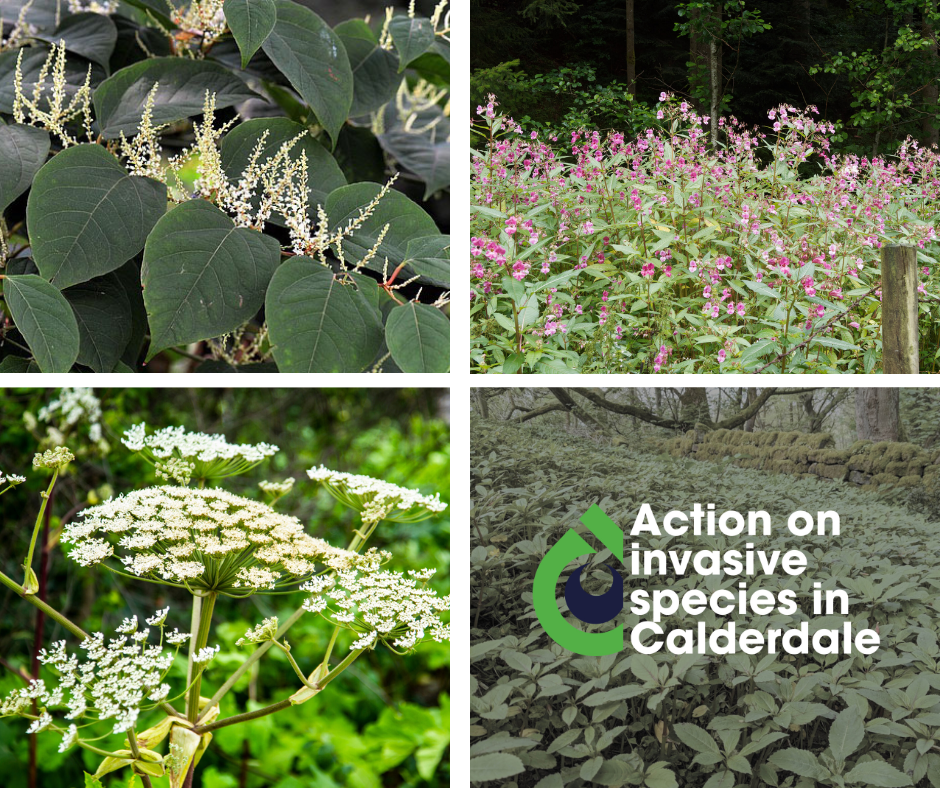
This Invasive Non-Native Species (INNS) week (12-18 May), Calderdale Council is raising awareness of the problems caused by invasive species and the actions people can take to prevent their spread.
Invasive non-native species are animals or plants that have been brought to an area in which they do not naturally occur. These species can spread rapidly and become dominant in the landscape.
INNS can outcompete or spread disease to native wildlife and cause damage to the environment.
Himalayan balsam and Japanese knotweed die back in autumn and winter, leaving the ground bare. This allows rainwater to flow more quickly over the surface, increasing the risk of flooding. This is a particular problem in Calderdale, as water can flow more quickly down the steep landscape, into the borough’s rivers.
The most impactful way that people can help is by reporting sightings of invasive species on the INNS Mapper app and website(external link). This is especially important for Japanese knotweed and Giant hogweed, as they require professional treatment and should not be removed by individuals. Himalayan Balsam can be easily removed with a few simple steps. A guide to ‘balsam bashing’ can be found at yisf.org.uk/community-toolkit(external link)
People can also help tackle the spread of invasive plants and animals, by remembering to ‘check, clean, dry’ their boots when out and about in the countryside.
The Council has installed a boot cleaning station at Jerusalem Farm, in the Luddenden Valley, using funding from Natural England and with support from the Environment Agency and Yorkshire Wildlife Trust. This is to protect the populations of white-clawed crayfish which are found in the brook at the site.
This threatened species is on the conservation red list, with numbers declining due to the introduction of the non-native North American signal crayfish. This invasive species is prevalent in many waterways in Calderdale, sadly spreading crayfish plague, a disease which kills the native white-clawed crayfish.
Other boot-cleaning stations, which have been installed by Yorkshire Water can be found at reservoir sites at Baitings, Ryburn, Withens Clough, and Scammonden.
During INNS Week, the Environment Agency is also hosting a number of webinar events, where people can find out more about the problem of invasive species and practical approaches to tackle their spread. People can find out more about these events and other INNS activities happening throughout the week and during the summer months, at eyeoncalderdale.com/blog/inns-week-2025(external link)
Calderdale Council’s Cabinet Member for Climate Action and Housing, Cllr Scott Patient, said:
“Managing invasive species is crucial for reducing flood risk and creating a more biodiverse Calderdale. INNS Week is an opportunity to highlight the problems that are caused by invasive species and how we can all help tackle them.
“Simple steps, like using boot cleaning stations, or making ourselves aware of the most problematic invasive species and reporting sightings, can make a big difference.
“As well as managing the spread of invasive plants, we also do what we can to protect native species, such as efforts at Jerusalem Farm, where we’re raising awareness of the plight of the native, white-clawed crayfish.
“Protecting threatened species and gathering information about wildlife in the borough is part of our ecological emergency plan, helping us to identify where specific conservation action might be needed.”
To find out more about invasive non-native species in Calderdale, visit eyeoncalderdale.com/invasive-species(external link)
Find out more about the Calderdale Ecological Emergency Action Plan and its key theme of ‘Protecting Calderdale’s Wildlife’, at Calderdale Ecological Emergency Action Plan(external link)
